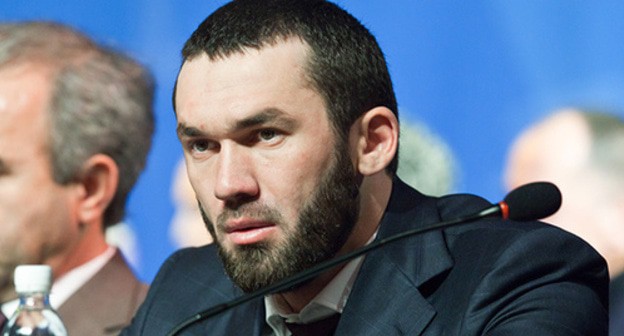The Vainakh Tribes in Ancient Times
The territory of Chechnya and Ingushetia has been inhabited by man since time immemorial that is evidenced by findings of archaic stone implements going back to the beginning of the Middle Palaeolithic Age (more than 40 thousand years ago). Besides that the traces of palaeolithic habitation have been found not only in the lowlands but also in the highland of Ingushetia and Chechnya. With the coming of copper metallurgy (in the Caucasus copper wares were produced in the 5th - 6th millenia B.C.) and cattle-breeding into existence the territory of the Northern Caucasus and particularly its mountainous region became developed more widely by man. As it is supposed, the advancement of the population further in the mountains is caused first of all by economic reasons, namely, the search for pasture-lands and demand for metal. In the Bronze Age and in the period of Early Iron (the end of the 4th - 1st millenia B.C.) farming and cattle-breeding were the basis of economy, of significant importance was hunting and gathering of wild honey as well. The social system was patriarchal-tribal.
Towards the end of the 2nd and in the first half of the 1st millenia B.C. the territory of Chechnya and Ingushetia was inhabited by two groups of the native Caucasian tribes, conventionally referred to as "the tribes of Koban and Kayakent-Khorochoy cultures" by the scientists. The formers inhabited Western Chechnya, Ingushetia and the area further in the west up to the upper reaches of the Kuban; as for the latters, they were the natives of Eastern Chechnya and Daghestan. The relation of these tribes to the population of other regions of the Caucasus is also traced.
The land of the Vainakhs is located in that part of the Caucasus through which the peoples of Europe and Asia paved the ways of trade and military-political relations since ancient times. Therefore, the entrails of the country conceal diverse monuments of material culture, the relics not only of the local autochthonal tribes, i.e., the direct ancestors of the Chechens and Ingushes, but also of the newcomer tribes who inhabited the territory for more or less long period.
Most ruinous were the invasions of the nomadic tribes from the northern steppes. The invaders not infrequently managed to seize the foothill plains of the Caucasus, pressing the native population back to the mountains.
The earliest incursion of the nomadic tribes into the Northern Caucasus evidenced by written historical sources is the invasion of the Scythians and their marches to front Asia via the Caucasus (7th century B.C.). The Iranian-speaking Scythian tribes, who came from the steppes of the Lower Volga and present Kazakhstan, first pounced on the population of the Northern Caucasus and, having overcome their resistance, penetrated through the Southern Caucasus and set off the plundering raids on the states of Front Asia. Assyrian cuneiforms and the ancient Greek historian Herodotus describe the actions of the Scythian military detachments in the countries of the Ancient East. As for the Georgian author, Leonti Mroveli, he deals with the struggle against the nomads in the Caucasus and a great deal of his information is evidenced by the results of archaeological excavations(1).
So, it turned out that many of the formerly densely populated settlements of the North Caucasus foothill belt stopped existing abruptly in the 7th century B.C. Archaeological investigations of the Serzhen-Urta hill in Chechnya, for example, have revealed a picture of destruction of a shelter of the local (Koban) tribes as a result of the brutal assault carried by the hostile tribes from the steppes.
According to Leonti Mroveli the Caucasians were defeated in the skirmish against the hostile strangers and retreated to the mountains where they consolidated the positions in the almost inaccessible ravines. Another ethnic term, durdzuks, standing for the ancestors of the Vainakhs, appears in the light of the afore-mentioned event in the Georgian chronicles. The term arises from the name of another legendary hero,"the most distinguished among the descendants of Kavkas" Durdzuk who, as suggested by Mroveli, led the Vainakhs in the mountains(2).
The border between the nomadic tribes and the highlanders ran mainly along the northern foot of the Black Mountains. But that was an uneasy border, as both the strangers and the settled mountaineers often made plundering raids accompanied by armed skirmishes.
Eventually, having recovered from a defeat the Vainakhs little by little began ousting of the strangers from the fertile foothill plains, but new strong units of nomads (Sarmats, Alans and others) would emerge from time to time in the Northern Caucasus and threw them back to the mountains.
Several toponymic names of the land of Vainakhs have come down to us owing to the vague recollections of this epoch. In the Chechen Plain, for example, two rivers, the Valerik and Martan, tributaries of the Sunzha River, run not far from each other. The name "Valerik" (or Valarg) means "the river of men's death" in Chechnyan. As for the "Martan" (or Mard-tan), this word can be translated from the Sarmat-Alanian language as "the river of murders", or "the river of death (or "the dead")". It appears that two neighbour rivers in the foothills southward of the Sunzha are given the same sombre names, though in the different languages. The historian V.Vinogradov, having compared these facts with the historical situation of the last centuries B.C., came to the conclusion that the area of two rivers was a borderland between the Vainakh and Iranian-speaking tribes and, at the same time, the arena of armed skirmishes, taking away the lives of lots of warriors of both sides. Those were the tragical events that caused the emergence of such specific hydronyms in the foothill zone of the North-Eastern Caucasus.
However, the relations between the nomadic tribes and highlanders consisted not only in mutual aggression. The nomads, having taken hold of the Caucasus foothill zone, gradually began to establish mutually beneficial and compliant economic and political relations with the inhabitants of the mountain gorges. Part of the nomads turned to the settled way of life and became engaged in farming, setting up the fortified settlements, the remains of which have been revealed on the territory of the Lowland of Chechnya. The chiefs of the Alan-Sarmathian and Vainakh-Daghestan tribes entered into inter-allied relations in order to carry on joint military campaigns in the rich countries located in the south of the Great Caucasus.
The rulers of ancient Iberia who controlled the main trade routes of the Central Caucasus did not fail to see in proper perspective the alliance with the martially disposed units of the North-Caucasian peoples. In the end of the 4th century B.C. Parnavaz, an Iberian of noble family rose in rebellion against the placeman of the Macedonian conquerors and called to the Sarmats and highlanders for help. Having gained a victory over the enemies and proclaimed himself King of Iberia, Parnavaz concluded a long-term military and political alliance with the tribes of the Northern Caucasus. According to custom of those times the alliance was strengthened with dynastic marriages; so, Parnavaz married his sister to one of the Sarmatian chiefs and he got married himself to the Durdzuk woman.
A good deal of interesting information on the military and political relations between the Vainakh tribes and ancient Georgia is contained in the "Kartlis Tskhovreba" (Georgian Chronicles). For example, it tells us about the rebellion of the Georgian feudal lords or "eristavi" (the rulers of the military and administrative districts of Iberia) against King Saurmag, son of Parnavaz. Saurmag secretly fled to the land of Durdzuks and applied to his mother's brothers for help. Having enlisted the support of the Vainakhs and Sarmats, together with the representatives of the Iberian nobility, still faithful to him, Saurmag launched an all-out offensive and suppressed the revolt (3rd century B.C.).
However, the relations between the neighbours were not always peaceful and inter-allied. During the reign of Mirvan, from the end of the 3rd to the early 2nd centuries B.C., the Durdzuks attacked Iberia, though suffered a defeat and took to flight. After that the Iberian kings tried to be more considerate towards the northern borders and began fortifying of the boundary area. The towers and strongholds blocking up the way to the enemies appeared in the mountain gorges through which ran the paths from the Northern Caucasus to Iberia. The garrison was complemented mainly by the native mountaineers.
In ancient times those passes were called "gates" by the people. And actually, those were the "gates" through which the hostile hordes of the northern tribes broke to Transcaucasia. Of particular importance in the Central Caucasus was the Daryali pass in the upper reaches of the Terek river (Dar-i-alan means "the Gate of Alans" in Persian). But in the mountains there were other passages of international significance not only in ancient times but also in the early Middle Ages. Thus the Georgian sources make a mention of the "Gate of Durdzuks", a gorge partitioned off with a stone wall, on the territory of Chechnya. Apparently the Durdzuk Gate was in the Assa gorge (Ingushetia) through which lies one of the paths connecting the Northern Caucasus Lowland with Georgia.
Despite the sporadic skirmishes between the peoples of the Northern Caucasus and Georgians the military and political alliance concluded under King Parnavaz remained valid on the whole in the first centuries of our era. Having become a strong state by that period Iberia pursued an active foreign policy, enjoying a wide support of the northerners. Let in the territory of Iberia the horse cavalry of the Alan-Sarmatian and Vainakh-Daghestan tribes threatened not only neighbouring Armenia and Albania but also the Parthian Kingdom and eastern provinces of the Roman Empire.
The Georgian historian Leonti Mroveli, author of the 11th century, deals with the ancient history of the Vainakh people. In his writings Leonti Mroveli describes the events that had taken place long before his times according to some ancient sources that have not come down to us, partially probably, dating back to the early Iberian period. Some information about the ancestors of the Chechens and Ingushes however can be found in the writings of the ancient epoch as well. Thus it is worthy of note that the name of the Gargar people is mentioned in the "Geography" by Strabo, as well as by Pliny Senior and Plutarch (1st - 2nd centuries A.D.). The Gargars became localized in the North-Eastern Caucasus in the neighbourhood of the Ghels and Leghs (Daghestan tribes), as well as of the Siraks, a Sarmatian tribe. It is to be supposed that in Gargars is retraced the ethnical community with the Vainakhs as this term ("gargar" in Ingush, and "gergera" in Chechnyan) exists today and means "relatives", "kinsfolk". According to some scientists even the name "Galgay", the present Ingushes gave themselves, is associated with the ethnic name of the Gargars.
Among the farmer tribes inhabiting the northern slopes of the Caucasus, the ethnicon "Isadiks" and "Khamekits" are met with further in the description of Strabo. Some scientists compare these terms with the names of tribal subdivisions of the Vainakh people - Sadoy (in Chechnya) and Khamkhi (in Ingushetia).
Notes
(1) Leonti Mroveli anachronistically calles the alien steppesmen "Khazars", by the name of the people inhabiting the steppe area north of the Caucasus. So, as it is considered to be established by the scientists the term "Khazars" in the given case stands for the Scythians.
(2) This information of the Georgian historian about the retreat of the Vainakh plainsmen to the mountains should not be understood as if the Vainakh tribes had not lived before in the mountainous regions.




![Tumso Abdurakhmanov. Screenshot from video posted by Abu-Saddam Shishani [LIVE] http://www.youtube.com/watch?v=mIR3s7AB0Uw Tumso Abdurakhmanov. Screenshot from video posted by Abu-Saddam Shishani [LIVE] http://www.youtube.com/watch?v=mIR3s7AB0Uw](/system/uploads/article_image/image/0001/18460/main_image_Tumso.jpg)